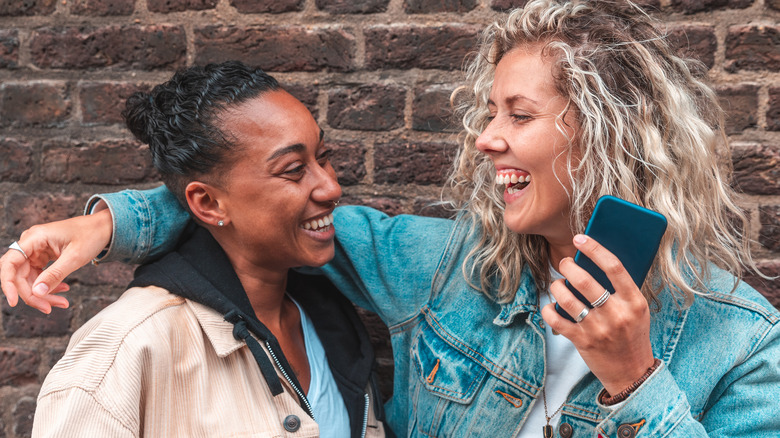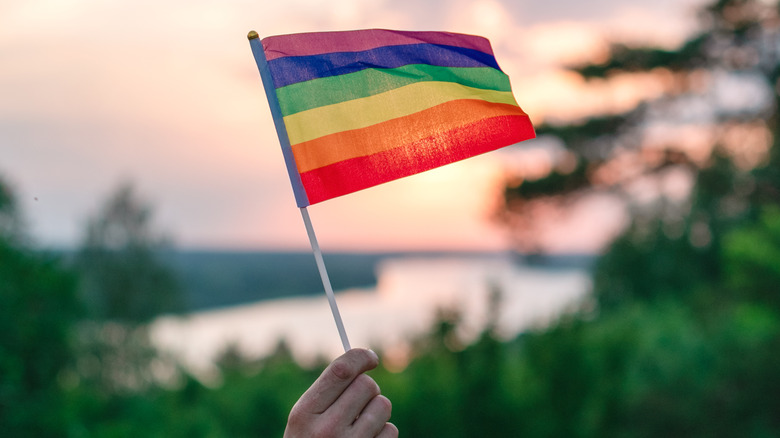Misconceptions About Asexuality You Need To Rethink
When some people hear the term "asexuality," they assume it's someone who doesn't have a drop of sexual desire in them. Not only that, but for those who aren't asexual, there's also the thinking that these folks are without the want for romantic relationships or intimacy in any way. Naturally, as is the case with sexuality as a whole, people really do miss the mark when it comes to understanding asexuality.
"Asexuality is largely misunderstood because there's a lack of visibility and education surrounding it — and that's because of the way we conceptualize sexuality in our society," asexual activist Yasmin Benoit tells Metro. "Most of our discourse around sexuality has emphasis on what people feel and do, rather than on what they don't, even though our experiences can be equally defined by both."
Because there's such a mass lack of understanding about asexuality and what it means to identify as asexual, there are far too many misconceptions out there — each one more absurd than the one before. But since it's imperative that we do our best to understand all the sexual orientations around us so that everyone feels validated and seen in their authentic selves, here are five asexual-related myths that need debunking.
Asexuals aren't sexual
Despite what some people might think, asexuals aren't celibate. Celibacy is a choice one makes, whereas asexuality, like any sexual orientation, is not a choice. According to The Asexual Visibility and Education Network, asexual people can be aroused and want to have sex. But where there's a shift when it comes to sexual desire, it's because the desire isn't as strong as someone who might be gay, straight, or bi. Also, for asexuals, when there's a lack of sexual arousal, they don't see it as a big deal or something to cause concern. But that still doesn't mean that the desire isn't there from time to time.
"Asexual people can have sex drives and have sex, or have kinks," asexual activist Yasmin Benoit tells Metro. "Sexual attraction is just one layer and manifestation of sexuality." Sex is simply not the most important part of a connection with someone, but that doesn't mean asexuals dismiss all types of sexual urges or don't have them.
Asexuals don't want relationships
It's human nature to want to have relationships and be close to other people. Whether that closeness comes in the form of friends or romantically speaking, people need people and need people in different ways. Emotional needs and sexual needs, although connected, are two ends of a different spectrum, so they don't necessarily have to be lumped together, but they do exist in the lives of those who identify as asexual. (via MindBodyGreen).
"The majority of the aces that I work with and know personally are romantic and desire a romantic connection," mental health therapist, LCPC Kari Holman tells Elite Daily.
One can be asexual in their sexual orientation but also be alloromantic in their romantic orientation. As James Joyce wrote, "Love loves to love love," so just because someone is asexual, it doesn't mean that the longing to be in love or have a romantic relationship is subtracted from the equation.
Asexuality is a disorder
As much as one would like to think that the days of categorizing sexual orientations as disorders were behind us, that's not the case. Up until 1973, the American Psychiatric Association's Diagnostic and Statistical Manual of Mental Disorders (DSM) had homosexuality listed as a mental disorder, and it wasn't until 2013 — less than a decade ago — that DSM was pushed to change the criteria of what a disorder is so asexuality could be removed from the list.
"It is very hard to access marriage counseling, relationship counseling, and mental health services if you're dealing with a professional who is not up on understanding asexuality and assumes it's the manifestation of a disorder," asexual writer Julie Sondra Decker tells Self. "I've heard from people who have been medicated because they're describing asexuality and the therapist or the mental health practitioner doesn't know what to call it besides low sex drive and thinks that they must want a higher sex drive." As Decker points out, even though DSM reclassified asexuality in 2013, the misunderstanding of it as an orientation still persists. However, asexuality is not, in any way, a disorder — nor was it ever a disorder.
Asexuality and queerness are separate
The fundamental lack of understanding has made it difficult for asexuals to find a place where their queerness is validated and accepted. It doesn't seem to matter to some that the "A" in LGBTQIA+ is for "asexual," but there's still bias (via National Geographic).
"Aces cope with a lot of erasure both within and outside of the queer community," mental health therapist, LCPC Kari Holman tells Elite Daily, "Even from identities that have also experienced erasure, such as bi."
Bisexuals have also long been dismissed because bisexuality is often seen as some sort of bridge people cross on their way to becoming full-fledged homosexuals. Bi-men, in particular, are often not taken seriously and are told they're just going through a phase (via Yahoo). It's this sort of ignorance that has put asexuals on their own island in a community that should embrace them as they embrace others.
There's only one way to be asexual
Au contraire, mon frère! Just like there's not one way to be gay or straight, there's certainly not just one way to be asexual. For example, those who identify as "grayasexual" very rarely experience any type of sexual attraction, while others identify as "aceflux," which are those whose sexuality fluctuates but they stay on the asexual spectrum (via Mic). Or, as researchers have labeled it, the Asexuality Identification Scale (via National Library of Medicine).
The takeaway when it comes to asexuality, or any type of sexual orientation, is that one shouldn't jump to conclusions or believe something offhandedly without doing their research. The complexities of sexuality can make wholly understanding an orientation difficult for some, but that doesn't mean you should let yourself be part of the problem by not trying to comprehend it. How people identify is a big part of who they are, so making the effort to see people as they want to be seen and respected for it is something we all deserve.





